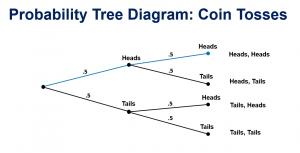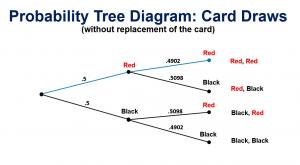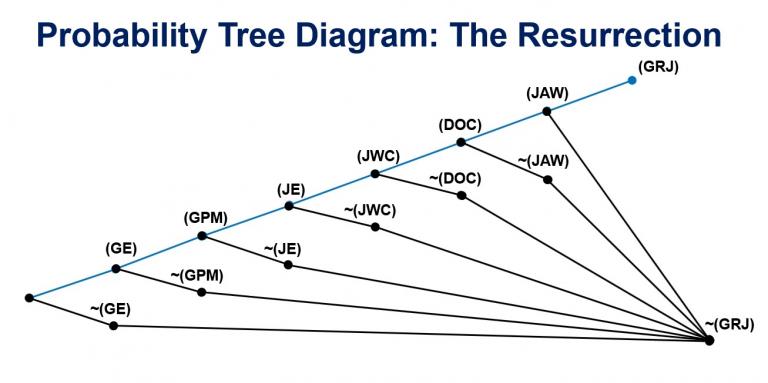Why I Reject the Resurrection – Part 5: Multiplication of Probabilities
INTRODUCTION
In this post I will spell out the basic logic of my current thinking about the probability of the resurrection.
First, I give an example of a probability tree diagram and calculation where the events are independent of each other (coin tosses). Next, I give an example of a probability tree diagram and calculation where the events are NOT independent (card draws). Third, I present a probability tree diagram and calculation for the claim that God raised Jesus from the dead.
PROBABILITY TREE DIAGRAMS
1. Probability Tree Diagram of Coin Tosses (click on image for a clearer view of the diagram):
Coin tosses are independent events. Whether you get heads or tails on the first coin toss has no impact on the probability of getting heads on the second toss. With a fair coin, the probability is always .5 that heads will be the outcome of a toss.
The above diagram represents a series of two coin tosses.
H1. The outcome of toss 1 is HEADS.
H2. The outcome of toss 2 is HEADS.
The probability that heads will be the outcome of the first toss and also the outcome of the second toss can be calculated by multiplying the probability of getting heads on the first toss times the probability of getting heads on the second toss.
P[(H1) & (H2)] = P(H1) x P(H2)
= .5 x .5
= .25
So, the probability of getting heads on both tosses is .25.
2. Probability Tree Diagram of Card Draws (click on image for a clearer view of the diagram):
Card draws (without replacing the card that was drawn back into the deck prior to drawing the next card) are NOT independent events. Whether you get a RED card on the first draw impacts the probability of getting a RED card on the second draw.
For example, if you get a RED card on the first draw, then there is one less card in the deck and one less RED card remaining in the deck. So, although the probability of getting a RED card on the first draw is 26/52 = .5, the probability of getting a RED card on the second draw (after getting a RED card on the first draw) is less than .5, namely 25/51 = .4902 (rounded to four decimal places).
The above diagram represents a series of two card draws. The probability that a RED card will be the outcome of the first draw and also the outcome of the second draw can be calculated by multiplying the probability of getting a RED card on the first draw (.5) times the probability of getting a RED card on the second draw given that the first card drawn was RED (.4902). So, the probability of getting heads on both tosses is equal to .5 x .4902, which is equal to: .2451 (rounded to four decimal places).
Although the outcomes of the draws are NOT independent events, we can still use multiplication of probabilities in the calculation, but the probability of the second draw must be understood in terms of a CONDITIONAL PROBABILITY:
R1. The first card drawn is a RED card.
R2. The second card drawn is a RED card.
To calculate the probability of getting a RED card on the first draw and a RED card on the second draw, we need to multiply the probability of (R1) times the probability of (R2) given that (R1) is the case:
P[(R1) & (R2)] = P(R1) x P[(R2)|(R1)]
P[(R1) & (R2)] = 26/52 x 25/51
= .5 x .4902
= .2451
3. Probability Tree Diagram of The Resurrection:
The first branch of the tree diagram concerns the probability of the existence of God:
GE. God exists.
Either (GE) is true or it is not. If it is not the case that God exists, then it is also not the case that God raised Jesus:
GRJ. God raised Jesus from the dead.
So, if ~(GE) is the case, then it is certain that ~(GRJ) is the case.
However, if God exists, then it is possible that God has performed miracles, but the existence of God does not imply that God has performed miracles. It is possible that God exists but does not perform miracles (other than having created the universe).
GPM. God has performed miracles.
Either (GPM) is the case or it is not. If it is not the case that God has performed miracles, then it is also not the case that God raised Jesus from the dead. So, if ~(GPM) is the case, then it is certain that ~(GRJ) is the case.
Either Jesus existed or it is not the case that Jesus existed.
JE. Jesus existed.
If it is not the case that Jesus existed, then it is not the case that God raised Jesus from the dead. So, if ~(JE) is the case, then it is certain that ~ (GRJ) is the case.
However, if Jesus did exist, then it is possible that he was crucified in Jerusalem around 30 CE, as the Gospels indicate:
JWC. Jesus was crucified in Jerusalem around 30 CE.
If Jesus was crucified in Jerusalem around 30 CE, then he might have died on the cross the same day he was crucified, as the Gospels indicate:
DOC. Jesus died on the cross the same day he was crucified.
If Jesus died on the cross, then he might have been alive again less than 48 hours later, as the Gospels indicate:
JAW. Jesus was alive and walking around in Jerusalem less than 48 hours after he was crucified.
If God raised Jesus from the dead, then the following claims are true:
(GE), (GPM), (JE), (JWC), (DOC), and (JAW)
However, even if all of these claims are true, it does not follow that God raised Jesus from the dead, because it is also possible that Jesus rose from the dead but this event was NOT caused by God but by some other being or force.
It is important to note that the probability calculation for this probability tree is more like the card draw example than the coin toss example. These claims and events are NOT independent of each other.
For example, if it is NOT the case that God exists, then that impacts the probability of the claim that God has performed miracles; if there is no God, if (GE) is NOT the case, then the probability of (GPM) would be ZERO. If it is NOT the case that Jesus existed, then it is also NOT the case that Jesus was crucified in Jerusalem around 30 CE. If (JE) is NOT the case, then the probability of (JWC) would be ZERO.
Because these claims and events are not independent, we need to use conditional probability when determining the probability of each branch of the tree diagram. It would be incorrect to simply multiply the probability of the existence of God times the probability that God has performed miracles:
P[(GE) & (GPM)] = P(GE) x P(GPM)
Rather, we need to use the probability that God has performed miracles GIVEN that God exists. This conditional probability is written like this:
P[(GPM)| (GE)]
The proper equation for the combination of these two claims is this:
P[(GE) & (GPM)] = P(GE) x P[(GPM)|(GE)]
As we follow the branches of the probability tree diagram to get to the final branch between (GRJ) and ~(GRJ), we need to understand that more and more assumptions are being added to the condition of the conditional probability. When we get to the final branch of the probability tree diagram, the probability of (GRJ) that we use as a factor in the calculation, is the probability of (GRJ) GIVEN that (GE) and (GPM) and (JE) and (JWC) and (DOC) and (JAW) are true:
P[(GRJ) | (GE) & (GPM) & (JE) & (JWC) & (DOC) & (JAW)]
This, of course, must be multiplied times the probability that all of those conditions or assumptions are true:
P[(GE) & (GPM) & (JE) & (JWC) & (DOC) & (JAW)]
Because these various conditions or assumptions are NOT independent of each other, we must also understand that the probability of the conjunction of these conditions or assumptions also requires the use of conditional probabilities. But the overall equation for the probability of the resurrection can be written in this “short” form:
P(GRJ) =
P[(GRJ) | (GE) & (GPM) & (JE) & (JWC) & (DOC) & (JAW)] x P[(GE) & (GPM) & (JE) & (JWC) & (DOC) & (JAW)]
The probability of the resurrection of Jesus is equal to the probability of the resurrection of Jesus GIVEN the various assumptions outlined here TIMES the probability of the conjunction of the truth of all those various assumptions.
THE NEXT POST
In the next post after this one, I will consider two objections to this logic.
The first objection seems to me to be correct, but I believe it to be a relatively minor problem with my logic. The second objection is based on the logic of Richard Swinburne’s thinking about the resurrection, and that objection, it seems to me, is potentially a more serious objection that might point to a major problem with my logic.
I don’t know if the second objection is correct, so I’m not ready to abandon the basic logic of my current thinking about the resurrection, but I do need to either come up with a plausible reply to this second objection or else make some modifications to the logic of my current thinking about the probability of the resurrection.



